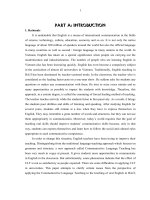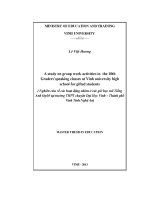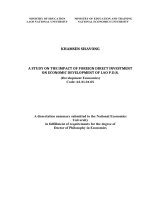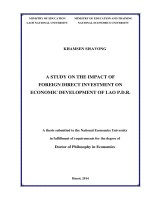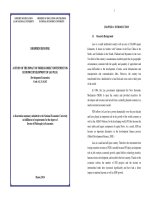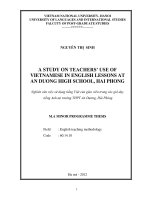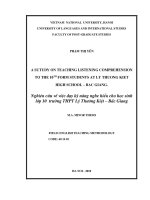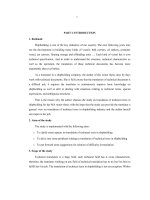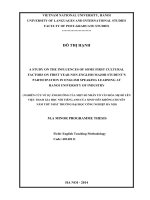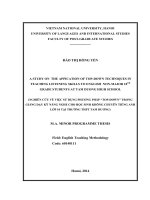A STUDY ON TEACHERS’ ASSESSMENT OF MICROTEACHING BY EFL TEACHER STUDENTS AT HUE UNIVERSITY OF FOREIGN LANGUAGES
Bạn đang xem bản rút gọn của tài liệu. Xem và tải ngay bản đầy đủ của tài liệu tại đây (596.34 KB, 112 trang )
MINISTRY OF EDUCATION AND TRAINING
HUE UNIVERSITY OF FOREIGN LANGUAGES
------------
A STUDY ON TEACHERS’ ASSESSMENT OF
MICROTEACHING BY EFL TEACHER STUDENTS
AT HUE UNIVERSITY OF FOREIGN LANGUAGES
MA THESIS IN THEORY AND METHODOLOGY
OF ENGLISH LANGUAGE TEACHING
In partial fulfillment of the requirements for the degree of Master of Arts,
Hue University of Foreign Languages
HUE, 2015
MINISTRY OF EDUCATION AND TRAINING
HUE UNIVERSITY OF FOREIGN LANGUAGES
------------
A STUDY ON TEACHERS’ ASSESSMENT OF
MICROTEACHING BY EFL TEACHER STUDENTS
AT HUE UNIVERSITY OF FOREIGN LANGUAGES
MA THESIS IN THEORY AND METHODOLOGY
OF ENGLISH LANGUAGE TEACHING
CODE: 60.14.01.11
SUPERVISOR:
HUE, 2015
i
BỘ GIÁO DỤC VÀ ĐÀO TẠO
ĐẠI HỌC HUẾ
TRƯỜNG ĐẠI HỌC NGOẠI NGỮ
------------
NGHIÊN CỨU VIỆC ĐÁNH GIÁ CỦA GIÁO VIÊN
ĐỐI VỚI VIỆC THỰC HÀNH GIẢNG DẠY THEO
QUY MÔ NHỎ CỦA SINH VIÊN NGOẠI NGỮ
TẠI TRƯỜNG ĐẠI HỌC NGOẠI NGỮ HUẾ
LUẬN VĂN THẠC SĨ LÝ LUẬN VÀ PHƯƠNG PHÁP DẠY HỌC
BỘ MÔN TIẾNG ANH
MÃ SỐ: 60.14.01.11
NGƯỜI HƯỚNG DẪN KHOA HỌC:
HUE, 2015
ii
STATEMENT OF ORIGINALITY
This work has not previously been submitted for a degree or
diploma in any university. To the best of my knowledge and
belief, the thesis contains no material previously published or
written by another person except where due reference is made in
the thesis itself.
Date: 02/ 8/ 2015
Signature
Full name
iii
ABSTRACT
This thesis reports a study on teachers’ assessment of microteaching by EFL
teacher students at Hue University of Foreign languages. It was carried out in order
to collect information about students’ perceptions and reflections of teachers’
assessment of microteaching, the present implementation of microteaching
evaluation, some existing pitfalls students encountered during the process of
microteaching assessment and some suggestions given to improve them.
A combination of both qualitative and quantitative approaches was used in this
study. In order to collect the data for the research, 100 students from Hue University
of Foreign Languages were invited into the study. Questionnaires, interviews and
observation sheet were used as data collection tools. The results from the
questionnaires were affirmed through interviews with open questions for 10
students. In addition, students’ microteaching evaluation sheets were collected to
illustrate how teachers evaluated students’ microteaching performance.
The results show that students at Hue University of Foreign Languages were
concerned with microteaching assessment, but their perceptions and reflections on
microteaching were different. Besides, the study found some pitfalls in applying
microteaching assessment such as time for microteaching, grading proportions, and
classmate students’ English proficiency.
From the findings of the study, some pedagogical implications were made so
that both teachers and students can do better towards assessing microteaching.
iv
ACKNOWLEDGEMENTS
I would like to express my heartfelt gratitude and appreciation to a number of
people, without whose support and involvement, this thesis would not have been
completed.
Firstly, I am deeply indebted to my supervisor for her continuous support,
encouragement, patience, dedication and critical feedback. From her, I have
acquired knowledge and research skills which are not only useful for conducting the
study reported in this thesis but only for my future career.
Secondly, I would like to thank my close friends in MA course at Hue College
of Foreign Languages for their enthusiasm and kindness to me.
My thanks are also sent to the fourth-students at Hue College of Foreign
Languages who were willing to take time out of their own busy schedule to
cooperate in my interviews and answering the questionnaire.
Finally, I would like to dedicate this thesis to my mother, my husband and my
children for their constant love, patience and support throughout the entire writing
process.
Hue, August 2015.
v
TABLE OF CONTENTS
Contents
Pages
SUB COVER PAGE
STATEMENT OF AUTHORSHIP
ABSTRACT
ACKOWLEDGEMENTS
TABLE OF CONTENTS
LIST OF ABBREVIATIONS
LIST OF TABLES
LIST OF CHARTS
vi
LIST OF ABBREVIATIONS
ARG
: Assessment Reform Group
EFL
: English as a Foreign Language
LCMT
: Learner-Centered Micro Teaching
U.S
: The United States
vii
LIST OF TABLES
viii
LIST OF CHARTS
ix
CHAPTER 1: INTRODUCTION
1.1. Rationale
Teacher is one of the most important factors in education of qualified people.
The teacher is someone that is trained and certificated to teach. He is regarded as
the key player in the entire educational process, the mirror in the society and the
father of knowledge. He is also the converter of raw materials to finished products
through a systematic procedure in the school which is considered as a human
factory.
According to Aslihan and Ahmet (2013), the most important role of the
teacher in a school is to guide students while providing knowledge. With this role,
the teacher shapes the terminal behaviors of the students, helps the student to have
positive relationships and makes them skillful. Besides, Kilic (2010) convinced that
the role of teacher was not transforming knowledge anymore. Their jobs are
guiding, orientation in students’ learning styles, positive learning environment.
However, teachers need to be trained to be able to apply their knowledge in
the classrooms effectively. Teacher competencies develop not only based on the
theoretical education during teacher education but through practical applications
(Yök, 1998; Nielsen, 2004). It is helpful to offer teacher training both oral and
written feedback on their micro-teaching activity. Due to the importance of
microteaching, there have been many researches on microteaching as a tool for
improving teacher education.
Actually, microteaching is a unique model of practice teaching so it can help
student teachers apply theoretical issues to real life situational teaching. The student
teachers who are trained to use the microteaching tool are expected to get good
technical teaching skills from their microteaching. Microteaching also helps them
improve both contents and methods of teaching. According to Can (2009), the more
effective the microteaching the better the opportunities for student teachers to
develop their teaching skills at their schools of practice. This is because
microteaching serves as training ground for teaching practice. Moreover,
x
microteaching serves as a meeting point between the theory and the practice for preservice training of teachers. Ike (2003) believed that microteaching was developed
as an answer to the question of how best can teachers be prepared for the teaching
profession. It is when student teachers acquire the necessary teaching skills through
microteaching that they are posted to the field for teaching practice.
Furthermore, microteaching helps teacher trainees develop skills such as
preparing lesson plans, speaking in front of a group, asking questions and using
evaluation techniques, etc. In this way there are many opportunities to learn
multiple skills that are important for teaching in a short time. Also, it makes it
possible to create an environment that involves thinking differently and interaction
(Gee, 1992).
Besides, microteaching is effective for teacher candidates/trainees in acquiring
individual skills of planning lessons, grabbing learners’ attention, presentation,
using the necessary materials, using reinforcements, asking appropriate questions,
using body language (Ananthakrishnan, 1993). Also, it is known that the act of
teaching a micro-lesson requires both the accuracy (grammar, vocabulary,
pronunciation and so on) in structures and fluency as well as the effectiveness in
communication. Thus, students can have opportunities to apply all knowledge they
have learned in teaching a micro-lesson.
Microteaching is a compulsory course for the fourth-year English pedagogical
students at Hue University of Foreign Languages. After students have learned about
teaching methodology theories, they have one course to practice and apply these
theories in the real life teaching cases. So this course is always important for the
pedagogical students. It gives students opportunities to practice and master theories
of the techniques in groups. Despite the fact that there have been several studies on
the topic of microteaching abroad and in Vietnam, there has been no research to
focus on the actual evaluation of teachers on the microteaching by English
pedagogical students. It is just necessary to carry out the proposed study to examine
the forms and contents of teachers’ evaluation on students’ microteaching.
xi
This study is meaningful to the teachers who are teaching or have taught the
course of microteaching to pedagogical students. Through answers in questionnaires
and interview of students, teachers will know their views and expectations so that
they can help their students learn well and gain high scores in microteaching.
Moreover, from evaluation of teachers, students will be able to adapt suitable
learning methods of learning to improve their performance in microteaching to gain
the best results in teaching. In other words, both teachers and students will benefit
from the results of this study.
Above are the reasons for which I have decided to choose this topic for my
research: A study on teachers’ assessment of microteaching by EFL teacher
students at Hue University of Foreign Languages.
1.2. Significance
This study aims to investigate the perceptions of EFL teachers and students on
teachers’ evaluation of their microteaching the actual microteaching was carried
out. Microteaching has been used to train student teachers at Hue University of
Foreign languages for many years. However, whether microteaching has been
applied effectively or not and what students think about teachers’ assessment of
their microteaching has not been studied. The study therefore aims to examine how
teachers’ evaluation of students’ microteaching, draw out implications to better the
process of evaluation and propose suggestions for pedagogical students to do
effective microteaching and for teachers to have more effective microteaching
courses. Moreover, the research will help teachers to perceive advantages and
limitations in microteaching assessment so that they may have appropriate
adjustment to increase efficiency of the course. Also, this research will provide
some measures to increase the effectiveness for microteaching evaluation.
Furthermore, the research will increase students’ awareness of evaluation in
microteaching. It also provides some measures to satisfy their concerns of
microteaching assessment.
xii
1.3. Research questions
This study plans to investigate the reality of teachers’ assessment of
microteaching by EFL teacher students at Hue University of Foreign languages. In
order to determine how microteaching can be assessed by teachers, it is important to
explore the processes such assessment is achieved. Therefore, this study aims at
seeking the answers for three following questions:
1. How are EFL teacher students’ microteaching evaluated?
2. What are EFL teacher students’ attitudes toward teachers’ evaluations of
their microteaching?
3. What are EFL teacher students’ suggestions to teachers’ evaluations of their
microteaching?
1.4. Research scope
The study was conducted at Hue University, College of Foreign Languages.
The participants of research included EFL teacher students. However, only the
fourth-year English pedagogical students were invited to participate into the study
because they have been taught the practicum course to practice their teaching skill
before graduating. Furthermore, assessment refers to general process of monitoring
or keeping track of learning progress. Assessment is a broader concept. In this
study, it is a part of the whole educational process of teaching and learning.
Evaluation occurred after assessment information has been collected, synthesized
and thought about. It means that evaluating was based on the facts and figures of
testing and assessment to judge the performance of learners.
1.5. Research significance
For teachers, this study will help them to recognize advantages and limitations
in microteaching assessment so that teachers can have suitable adjustments to
increase efficiency and reduce the restrictions. Furthermore, this study will provide
some measures to increase the effectiveness for microteaching evaluation.
Moreover, for students, this research hopes to increase students’ understanding of
evaluation in microteaching. Besides, it provides some measures to satisfy their
xiii
concerns of microteaching evaluation. The third significance of the thesis is to
document students’ suggestions to improve the microteaching assessment.
1.6. The structure of the thesis
This study consists of five chapters:
Chapter 1: Introduction: states a general direction of the thesis, rationale,
purposes, research questions, research significance and the scope of the study.
Chapter 2: Literature review: clarifies concepts of terms, relevant literature
review on microteaching assessment, pitfalls in assessment, and assessment criteria.
Also the previous studies related to the current are analyzed.
Chapter 3: Research methodology: outlines the research approaches, methods
of data collection, and data analysis.
Chapter 4: Findings and discussion: report, analyze collected data and discuss
them in the light of the literature.
Chapter 5: Conclusion and suggestions: summarize main findings and give
out some suggestions that might help other researchers to conduct further
investigation in the same research topic.
xiv
CHAPTER 2: LITERATURE REVIEW
2.1. Introduction
This chapter states a general idea of microteaching. It also focuses on definitions
of assessment, and microteaching assessment. Furthermore, microteaching purposes,
principles and types are presented. Lastly, the chapter presents review of previous
studies related to the current one.
2.2. Microteaching
Microteaching has been defined as “a scaled down realistic classroom training
context in which teachers, both experienced and inexperienced, may acquire new
teaching skills and refine old ones” (McKnight, 1980, p. 214). This technique is
developed at Stanford University in the United States Stanford and it is a way to
better trainee teachers in the early and mid 1960’s for elementary school teachers.
In the late 1960s and early 1970s, the use of microteaching spread rapidly in
the U.S, Europe and some other developing countries. In addition, Konstantinos
(2012) defined microteaching as a method of teacher training that is current and
effective for acquisition of specific teaching skills. It is considered as a training
technique for prospective teachers in Universities and Colleges of Education.
Microteaching serves as a precondition for the improvement of the quality of
Education.
Also, microteaching is a method that has been used for many years in teachinglearning environments. It is a remarkable factor used in teaching practices of preservice teachers (Görgen, 2003). Microteaching method offers new and different
opportunities to pre-service teachers about the planning and implementation of new
teaching strategies. Microteaching has an important place in preparation for the
teaching profession because of its potential to emphasize the relationship between
theory and practice (Ajayi-Dopemu and Talabi, 1986). Microteaching is a technique in
teacher education which provides a transition from theory to real teaching situations
(Çelik, 2001). Microteaching is one of the efforts by the pre-service teachers to
transfer the knowledge and skills into action, and thus, they try to bridge the gap
xv
between the theory and practice (Gürses, Bayrak, Yalçı Açıkyıldız & Doğar, 2005).
In microteaching practice, lesson duration is short (5-20 minutes) and the number of
the students is few, with no more than 20 minutes (Külahçı, 1994). In respect to
subject, teachers work to meet the teaching skill.
Besides, Görgen (2003) states that pre-service teachers can experience real
teaching situations with microteaching, and they have the opportunities to transfer
their teaching knowledge into practice. Thus, it can be said that microteaching can
provide the possibility of forming a trial situation for teaching activities. In
microteaching, pre-service teachers find opportunities to develop skills to prepare
lesson plans, choose teaching goals, take students’ attention, speak in front of
group, ask questions, managing time effectively, and assessment techniques (Kılıç,
2010). In this way, pre-service teachers improve their classroom management skills.
It provides expert supervision and a constructive feedback and above all if provides
for repeated practice without adverse consequences to the teacher or his students
(Ananthakrishnan, 1993). Micro-teaching practices improved both student’s and
teachers' self-confidence and the teaching skills are emphasized (Şen, 2009; Şen,
2010). There have been researched indicating that microteaching is useful, preservice teachers can gain much in case of using microteaching and that their views
on teaching can improve much with the help of microteaching.
Ofoefuna (2002) defined microteaching as a component skill approach to
teachers’ preparation and training. Without adequate acquisition of teaching skills,
learning process cannot be effective. McKnight (2003) viewed microteaching as
laboratory training procedure for simplification of the complexities of teaching –
learning process. In the attempt to define the concept of micro-teaching, Abifarin
(2004) examined the two words involved: micro and teaching. Micro means
something that is small while teaching means the art of giving instruction. When the
two words are joined together, it becomes micro-teaching, which means giving
instruction on a smaller scale. In agreement with Abifarin, Ajayi (2006) described
micro-teaching as a system of controlled practice that makes it possible for student
teachers to concentrate on specific teaching behaviors.
xvi
In addition, Yusuf (2006) described microteaching as the practical training
technique which gives the students and the teacher the opportunity to master the
skills inherent in teaching in a laboratory environment before actual class
experience. Adewoyin (2007) defined micro-teaching as an instructional method
employed in the professional training of teachers. Aggarwal (2007) described
microteaching as a training procedure that aims at simplifying the complexities of
the regular teaching procedure. The student teacher engages in a scaled down
teaching situation in terms of time, class size, content of the subject matter and
teaching tasks. Teg (2007) defined microteaching as a process whereby student
teacher learns to acquire the rudiments of teaching in the classroom. Microteaching
prepares student teachers on what they need to master before going to the field for
teaching practice. Microteaching is a course or practical experience which prepares
the student teachers ahead of the challenges that await them in their future teaching
career as educators. Patel and Mohasina (2011) described microteaching as an
organized practice teaching which aims at giving instructors confidence, support
and feedback. It is a quick, proven and fun way of helping teachers get off to a
strong start. It is designed for the training of both pre-service and in-service
teachers.
Furthermore, Egunjobi, Nwaboku and Salawu (2011) described microteaching
as a program that prepares student teachers for the main teaching practice. They
explained that microteaching is an indispensable course for student teachers. This is
because they need to observe and acquire for teaching tasks. Isa and Jusoff (2011)
considered microteaching as the ultimate sessions where the undergraduates put into
practice theories. Also, Singh (2011) described microteaching as a safe practice, a
vehicle for continuous training and a new approach to supervision.
In addition, Saxena and Khajanche (2012) explained that microteaching is a
teacher training technique which helps the student teachers to master the skills of
teaching. Recently, Tidwell (2013) viewed microteaching as a session of practice
teaching that is videotaped for the teacher to watch. Microteaching is suitable for
potential, new and existing teachers to review their teaching techniques and receive
xvii
feedback from fellow teachers and administrators. The feedback received is used for
making corrections to their teaching style accordingly. As every human activity or
behavior is geared towards achieving a purpose so also, microteaching has aim,
goals and objectives. Microteaching as an innovation in education has intention of
training pre-service teachers in skills acquisition so as to make them effective and
professional.
Moreover, Kpanja (2001) states that microteaching has been viewed as a
successful method in teaching candidates’ education and used in several places,
stages of professional development for some time. I totally agree with those defined
notions as the matter of fact that during every course of microteaching, the advisor
usually sits and watches the teaching performance of the trainees. He or she does
not interrupt the lesson but records the problems, which are used to provide feedback and correction after the microteaching lesson. Thus, the microteaching to
preserve teacher education programs is more effective than tradition teaching.
Microteaching has been implemented into methodology courses in an attempt
to increase the effectiveness of the course as well as the teacher education overall.
As microteaching provides students with opportunity to explore the field of
teaching and gain knowledge and skills that are necessary for future teaching, it has
been widely adopted in teacher education programs as a professional development
tool (Benton-Kupper, 2001 & Wahba, 2003).
And Slagoski (2007) also indicates that by letting the trainees try out a short
slice of what they plan to do with their students in front of their fellows,
microteaching aims to give them confidence, support, and feedback as well. Sharing
the same idea, Benton-Kupper (2001) states that microteaching helps pedagogical
students improve their teaching skill by providing them with opportunities to
practice on their performances. Nowadays, as the consequence of adapting the
communicative approach more and more in classroom, the role of learners, in
general, and language learners, in particular, is put more emphasis on.
xviii
2.3. Aims of microteaching
The major objective of microteaching as enumerated by Aggarwal (2008) and
Jason and Tiffany (2010) is to enable student teachers to learn and assimilate new
teaching skills under controlled conditions or environment. Microteaching enables
student teachers to master a number of teaching skills which empower them to gain
confidence in teaching. One time- honored adage says: “You cannot learn to swim
if you do not get in the water”. Another objective of microteaching mentioned by
Ajibade (2009) is that it is geared towards equipping student teachers to gain
confidence in teaching. This it does by making the student teachers to master a
number of skills on a small group of students. Gorgen (2003) stated that
microteaching aimed at helping student teachers to gain confidence and research
skills. Through microteaching, student teachers can gain pre-service and in-service
teaching experiences and academic self-confidence.
The purposes of microteaching mainly relate to the effort to “give instructors
confidence, support, and feedback” for what they are planned to do with their real
students in the future. “Simple, single concept lessons” (Allen & Wang, 2002,
p.1620) help them pay attention to their performance, resulting in detailed analysis
of the microteaching practice. Their application of every aspect of teaching
methodology is put into careful consideration to see what has come up to expected
standard and what has not. This is what can be done in a microteaching session
only, not in a usual long and complicated lesson in which the teacher tends to
“cover far more materials than students could absorb” (Dadswell, 2000, p.1).
Besides, Bell (2007) describes micro-teaching as the common practice of having
student teachers in educational method courses “teach” a lesson to their peers in
order to gain experience with lesson planning and delivery. He insists that microteaching is a system of controlled practice that makes it possible to focus on specific
teaching behaviors and practice teaching under controlled conditions.
Moreover, micro lessons are great opportunities to present sample “snapshots”
of what/how you teach and to get some feedback from colleagues about how it was
received. It's a chance to try teaching strategies that the teacher may not use
xix
regularly. It's a good, safe time to experiment with something new and get feedback
on technique. Micro-lesson study as an aspect of micro-teaching which according to
(Fernandez and Robinson, 2006) is a cooperative learning experience which intends
to challenge prospective teachers’ thinking about teaching and learning, and to
encourage their connection between theory and practice.
Also, several studies have revealed that microteaching comprises practical
experiences for meeting the desired objectives of training teachers to become
effective and reflective in teaching profession (Benton-Kupper, 2001; Amobi, 2005;
Eick and et al., 2005). In this sense, microteaching activities enhance student
teachers to gain professional experiences such as efficiency on preparing and
applying lesson plans by taking target students’ capabilities, learning capacities,
needs, and expectations. In consequence of such experiences, they become more
conscious about their future occupations and can be able to implement teaching
issues successfully in real school environments. Some studies have concluded that
microteaching activities help student teachers overwhelm their anxiety levels, defeat
hesitation and fear, increase professional commitment, raise consciousness about
teaching profession, become efficient in all topics related to teaching proficiency,
learn how to interact with students, become experienced in testing and evaluating,
become professional for taking student’s attention to lesson, consume time
professionally, utilize educational technologies, and control classroom management
(Arends, 2000; Karamustafaoglu and Akdeniz, 2002).
Futhermore, the efficiency of microteaching on gaining professional
consciousness is generally agreed; additionally, microteaching helps student
teachers analyze their present teaching performance in order to discover their
strengths and weaknesses by engaging in reflective practice. Reflective practice in
teaching implies a tendency to revisit the sequence of one’s teaching for the purpose
of making thoughtful judgments and decisions about improved ways of acting in the
future, or in the midst of the action itself (Kottcamp, 1990). Due to the reflection by
teacher educators while student teachers are teaching, reflective habits of mind can
be extended (Valli, 1997); in this sense, the quality of reflection is directly related to
xx
guiding student teachers to use all aspects in their teaching experiences. Further,
microteaching technique is a reflective learning process shaping student teachers’
professional growth. Therefore, microteaching activities need to be considered as
positive experiences which improve the development of professional awareness.
According to Allen and Ryan (1969), microteaching indeed gives the real
teaching. Although the teaching situation in micro teaching is constructed in a
scene, yet it is real teaching, having real purposes. Also it helps to reduce the
complexities of real class room teaching. The class time, duration and skills are
reduced. Besides, microteaching also focuses on training: the main focus of
microteaching is to train the teachers and expand knowledge of results. In micro
teaching, at the end of teaching session, teacher trainees exchange their views and
provide guidance. In this way improvement is done. One can improve his/her
performance as a result of feedback. Furthermore, microteaching enables teacher
trainees to analyze and develop teacher behavior under laboratory conditions, gives
confidence to the novice teachers to go to real class room. Also it is helpful for pre
service teachers for imparting skills in them, helpful for enabling trainee teachers
regarding small group interaction and for novice teachers in developing reasoning,
problem solving, and creativity among small group. Moreover, microteaching
brings evaluative techniques in teacher trainees as well as enables the students in
managerial tasks such as discipline, classroom management etc.
Besides, microteaching provides a training opportunity for student teachers
who benefits from mall of the advantages of the situation. Such advantages are
student teachers can able to act as pupils, as teachers, as sources of feedback and as
video operator. In other words, the instruction using of the microteaching in
teaching practice may be effective on decreasing the pre-service teachers’ teaching
anxiety in language or other areas. Therefore, if the teacher education programs
hope to influence the development of effective instructional practices for student
teachers, they may focus on expanded microteaching in teaching practicum
course. Virtually any institution can adopt this microteaching model because of its
xxi
flexibility and efficiency.
It is effective not only because it focuses on good
teaching practices, but also because it promotes collegiality
Kilic (2010) convinced that teachers’ jobs are guiding, orientation in students’
learning styles, positive learning environment. Also, the teachers need to consider
what to teach, how to teach, where to teach, how to evaluate and how to and where
to use the evaluation results based on the need of their student in learning.
Moreover, microteaching has long been used as a professional development tool in
teacher training program. Kilic (2010) found that microteaching helped teachers to
better understand the processes of teaching and learning. It provides teachers with
opportunities to explore and reflect on their own and other’s teaching styles and to
acquire new teaching techniques so microteaching is hypothesis in which teacher
candidates or even experienced teacher practice the specific teaching context. It is
thought that microteaching should be conducted as similar as real situation so that it
can get the best result and potential mistakes were minimized in lowest level.
2.4. Stages of microteaching
In this pattern of paying close attention to all aspects of teaching action, a
microteaching cycle comprises teach, review and reflect, re-teach (Arends, 2000).
First of all, a microteaching lesson is initiated by teaching stage in which student
teachers teach a lesson. While teaching, they are observed by their classmates and
educator; then, the lesson is discussed for evaluating student teachers performance;
after that, in re-teaching stage, student teachers re-teach the lesson with regard to
the proposed points in the discussion and evaluation stage.
Preparing lesson plans, as part of microteaching activities, in conformity with
the syntax of the lesson cycle is the initial stage of microteaching. Preparing lesson
plans are influential for gaining teaching experiences and making decisions on
teaching points, and great differences can be observed between the lesson plans
prepared and applied by less experienced teachers and experienced teachers
(Richards, 2001). Because less experienced teachers may tend to follow their plans
and seem devoted to teaching depending on it during teaching process, while
xxii
experienced ones may tend to divert from their lesson plans at some points for
making decisions or adding activities to provide more practice when necessary. In
this sense, teaching practice through microteaching can be assumed as a boosting
activity for any interactive decision to be made during teaching. Thus, student
teachers may gain experiences to make quick decisions in their lesson plans.
Although organization of any course is usually planned before teaching and
the activities are arranged regarding the course duration and the needs of target
group, making changes in the prepared lesson plan may be required in some cases.
Therefore, the sub-divisions of a lesson plan into which activities are included are
ongoing processes and can be modified by teachers when any problem is
encountered (Woods, 1996). Hence, the success of a micro lesson is directly related
to lesson planning with comprehensible objectives in a planned sequence. Initiating
the lesson by gaining the attention of students at the beginning of the presentation,
presenting the planned lesson by explaining and giving examples, using gestures
and body language during the presentation, focusing on the core of the planned
lesson, using teaching and audio-visual aids properly, highlighting ambiguity and
encouraging student participation, asking and responding questions, and concluding
the teaching session by self-evaluation of student teachers and their classmates are
all the subsequent stages of a micro lesson.
In this context, depending on the implementation of microteaching activities, a
number of studies reveal that microteaching is an effective means of improving student
teachers' teaching skills depending on the prepare lesson plans (Yeany, 1978, Arends,
2000) and a tool of continuous training applicable at all stages of the teaching
profession. Although microteaching has long been used as a professional development
tool in teacher training programs, student teachers are sometimes reluctant to involve in
microteaching activities due to non-natural classroom environments, material
production procedures, time limited course schedules, etc., so this unenthusiastic
attitude reduces the efficiency of microteaching (Stanley, 1998).
In addition, lack of satisfactory awareness of the use of microteaching has led
to criticisms that microteaching produces homogenized standard student teachers
xxiii
with model procedures and stands for a form of teaching play in unnatural
surroundings, that is, the artificiality of classroom environments; in addition, the
cost and maintenance of equipment regarding reduced budgets of student teachers,
the amount of time for preparing materials, the difficulty of material production
may also cause unwillingness (Cripwell and Marion, 1982). The general emphasis
on practice with regard to microteaching disappears during student teaching,
although students still stress the importance of preparation in general. They attribute
this change to the students’ perceptions of a lack of time for complete preparation
(Lederman and Gess-Newsome, 1991). Consequently, limited time for preparation
and wastefulness of microteaching may create obstacles in teaching processes of
student teachers and lead them to develop reluctant attitudes in teaching
experiences. Despite these criticisms, in-depth awareness of microteaching, the
motivation of the student teacher to improve himself/herself and the ability of the
observer to offer comprehensive feedback may bring into remarkable improvements
in teaching skills. Therefore, this article deals with how efficient microteaching as a
teaching tool in teacher education is and examines the student teachers’ enthusiastic
and reluctant attitudes towards microteaching activities.
The student teachers are required to teach a single concept, use a specified
teaching skill, use a specified teaching skill for a short time and use the skill on a
very small number of pupils. According to Allen and Ryan (1969), microteaching is
a real teaching situation where the complexity of the real classroom teaching is
reduced. The reduction is done in terms of class size (population), time (duration)
and content (task to be accomplished). The student teachers who are regarded as the
micro-teachers teach between 5-10 pupils who are likely to be their classmates,
colleagues and friends instead of facing the real classroom situation of about fifty
(50) pupils. Instead of teaching for forty (40) minutes as it is in the real classroom
situation, the micro-teachers prepare their lesson plan and teach for maximum often
(10) minutes. Micro-teaching is mainly on the practice of teaching in which a
number of learners are involved. The thinking behind it is that a pre-service teacher
should be guided to practice with a smaller number which may be gradually
xxiv
